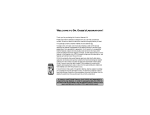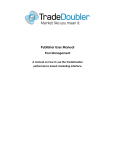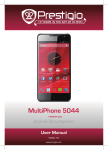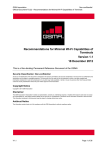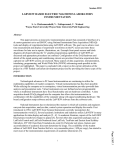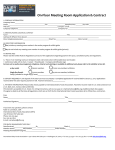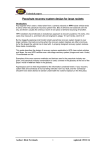Download Mobile Marketing Strategy Guide
Transcript
TheMail | Mobile Marketing Strategy Guide | By: Murray Newlands Mobile Marketing Strategy Guide By: Murray Newlands 2 TheMail | Mobile Marketing Strategy Guide | By: Murray Newlands Disclaimer & Terms of Use Agreement The author and publisher of this e-‐book have used their best efforts in preparing the accompanying materials. The author and publisher make no representation or warranties with respect to the accuracy, applicability, fitness, or completeness of the contents of this e-‐book. The information contained in this e-‐book is strictly for educational purposes. Therefore, if you wish to apply ideas contained in this e-‐book, you are taking full responsibility for your actions. The author and publisher disclaim any warranties (express or implied), merchantability, or fitness for any particular purpose. The author and publisher shall in no event be held liable to any party for any direct, indirect, punitive, special, incidental or other consequential damages arising directly or indirectly from any use of this material, which is provided “as is”, and without warranties. As always, the advice of a competent legal, tax, accounting or other professional should be sought. The author and publisher do not warrant the performance, effectiveness or applicability of any sites listed or linked to in this e-‐book. All links are for information purposes only and are not warranted for content, accuracy or any other implied or explicit purpose. This e-‐book is © 2013 copyrighted by Murray Newlands. No part of this may be copied, or changed in any format, sold, or used in any way other than what is outlined within this e-‐book under any circumstances. 3 TheMail | Mobile Marketing Strategy Guide | By: Murray Newlands About Murray Newlands Murray Newlands is the Founder and Editor of The Mail www.themail.com and Deputy Editor of Search Engine Journal. He founded The Mail in 2013 where he writes and makes videos about performance marketing covering topics as broad as email marketing, lead generation, mobile marketing, as well as content marketing. Murray is an advisor to a number of bay area startups including VigLink. In 2011, Wiley published his book Online Marketing: A User's Manual. Born in England, Murray moved to the USA in 2011 after being recognized by the US government as an alien of extraordinary ability. Murray is a winner of the prestigious AFFY award. 4 TheMail | Mobile Marketing Strategy Guide | By: Murray Newlands Chapter 1: Introduction In 2013, there’s no doubt that mobile marketing is quickly becoming the next frontier in the digital marketing industry. In fact, surveys have shown that tablets will out sell desktop computers this year for the first time ever, and many eCommerce brands have reported that a significant portion of their traffic and sales have started to come from the mobile platform. As smartphones and tablets begin to take hold of the digital marketing industry, it’s more important now than ever that you know the ins and outs of mobile marketing, and that is exactly what this book is intended to do. If you are new to mobile marketing, this book will serve as your guide to success in the industry, teaching you exactly what you need to know in order to capitalize on this rapidly emerging marketing strategy. From defining different aspects of the industry, to offering tips on how to successfully run your campaigns, Mobile Marketing for Professionals will serve as your one-‐stop-‐shop for everything mobile marketing. What Is Mobile Marketing? Mobile marketing is a digital marketing practice that employs performance-‐based advertising techniques to drive traffic, downloads, app installs, and sales via cellular phones, smartphones, tablets, and other mobile devices. Mobile marketing offers advertisers a number of benefits such as time and location-‐based targeting and customized ads that traditional and online advertising cannot provide. There are a number of different mobile marketing practices, including SMS messaging, push notifications, location-‐based targeting, and in-‐game marketing—all of which can provide advertisers with unique ways of reaching consumers who are constantly on the go. Mobile Network Operator, Carriers, & Manufacturers A Mobile Network Operator, otherwise known as a wireless carrier, mobile carrier, or cellular company, is a company that provides wireless communication services to mobile users. Depending on where you are in the world, there could be any number of different MNOs, which you will need to keep in mind for targeting purposes. There will be more detail on that later in the book. Mobile Manufacturers are companies that produce mobile devices such as smartphones and tablets, and sell their products to MNOs. For example, Apple is a mobile manufacturer who makes the iPhone and iPad. As mentioned before, knowing the different 5 TheMail | Mobile Marketing Strategy Guide | By: Murray Newlands manufacturers, makes, and device models will be a large part of creating and running campaigns that work; but, more detail on that later. Feature Phones, Smartphones, & Tablets In the world of mobile devices, there are three main types of devices—feature phones, smartphones, and tablets—and it is important to know the difference between them when you are deciding of what types of offers to run. A feature phone is a mobile device that is not considered to be a smartphone due to a lack of certain features such as Wi-‐Fi accessibility, GP navigation, web browsers, and more. These phones are intended for users who desire a less expensive phone with fewer features. A smartphone on the other hand is a mobile phone that uses a mobile operating system and has a much more advanced connectivity and computational ability than a feature phone. Most modern smartphones have high resolution touch screens, web browsers, GPS units, media players, and more built into them. Furthermore, smartphones have advanced accessibility through 3G and 4G mobile broadband networks, as well as Wi-‐Fi connectivity. Another defining feature of a smartphone is that their advanced application programming interfaces, otherwise known as an API, enables them to run third-‐party applications that have better integration with the device’s operating system. Most feature phones lack an API and run on their own proprietary software system. A tablet is a mobile computer that is larger than a mobile phone and uses a touch screen rather than a traditional computer keyboard. Along with their on-‐screen keyboard, many tablets use a digital pen or passive stylus pen as well. Most current tablets have features including: wireless mobile browsing connectivity (2G, 3G, 4G, or Wi-‐Fi), some cell phone functionality such as messaging and video calling, GPS, video and still camera hardware along with photo and video editing and viewing software, downloadable applications, portable media players, and email and social media programs. Tablets typically come with a battery life that ranges from three to twelve hours and weigh about one or two pounds. The Apple iPad is currently the highest selling tablet on the market, with many Android devices following close behind. 6 TheMail | Mobile Marketing Strategy Guide | By: Murray Newlands Chapter 2: Mobile Offers & Campaigns Mobile Lead Generation Mobile lead generation is a type of mobile affiliate marketing in which publishers get paid anytime a visitor fills out a lead form, single opts in or double opts in to a mailing list. A good example of this would be if you are promoting an offer for a clothing retailer. When the visitor lands on your site and fills out your form, including their name and email address, the conversion pixel on the page will fire and you will be receive a payout for that action. Depending on the mobile carrier, type of phone, and operating system, there will be plenty of different types of lead generation offers available. Mobile Applications Today, there are billions of mobile applications in mobile marketplaces and app stores, meaning that there are plenty of ways to use mobile applications for marketing. One of the most popular ways to make money from mobile apps is through driving app downloads for brands. For example, many mobile game developers will pay you to drive traffic to download their games or apps, and you will be compensated on a per-‐download basis. Promoting Your App and Generating Downloads By: Alex Genadinik, Founder, Problemio Since creating my first mobile app, it has been downloaded over 150,000 times in almost a year. I have been using it to promote my paid products to some degree of success, but what I have discovered along the way is that video is much more successful at getting people to buy the paid apps. Once I started my YouTube channel I noticed that the conversion rates from the videos could sometimes be as much as five times greater from video than from the free apps. It’s this type of real-‐world knowledge and first hand experience that will help you boost installs, up your new user acquisition, and make your mobile application marketing campaign a success. By following the advice below, you should see some success in your own mobile app campaigns. 1. The single best way to promote your mobile app is with app store SEO, also commonly referred to as ASO—You have to know which keywords your app should rank for and which keywords it will be able to rank for. For most apps, the app store drives over 50% of their downloads. 2. Have a YouTube channel that promotes your app—YouTube is a gigantic platform 7 TheMail | Mobile Marketing Strategy Guide | By: Murray Newlands and if you can get many views for your videos, you can add calls to action for people to get your app. Here is an example of my channel, in which, as you can see, there are many videos on all sorts of business topics. In each video, I have calls to action for people to get my apps. I started making business videos for this YouTube channel two months ago, and it has already increased my app download revenue by 10%. Here is a video example in which I first teach something about business, and then promote my apps. 3. Make your app social from inside the app—Even though my apps are for business, which isn't particularly social, I have created features where people can collaborate on creating their business plan together. That gives incentive for users to invite new users. And that has given me about a 5% increase in downloads and revenue. 4. Maintain a website and a blog and drive people from them to your apps—I actually maintain these sites separately. I blog at http://www.glowingstart.com and have a more traditional app website at http://www.problemio.com. Having these sites also gives me a 5% boost in downloads, but it can give you a much greater boost. The more traffic you can get to your site, the more downloads you can drive to your app. 5. Create pages and videos for long-‐tail searches that might have good download potential for your apps—Here is an example of how I am promoting my Amazon Kindle apps. I have this page that I am trying to get to rank in Google for the term "Kindle business apps" and this video that is meant to rank in YouTube for the term "best Kindle business apps" (already ranks #1 on YouTube) and "Kindle business apps" (also #1 on YouTube). Not only that, but if you search Google for the term "best kindle business apps" the video itself already ranks as #12, and I only put the video and the blog post together five days before writing this article. In conclusion, if you are looking for a proven way to drive traffic to your apps and boost new user acquisitions, videos and blogging are good way to do it. However, simply throwing some videos on YouTube and directing people to your app won’t suffice. Take your time, craft a strategy that will be engaging and interesting to the people that you want downloading your app, and you will be able to generate loads of installs in short order. Click To Call A “Click To Call” campaign is exactly what it sounds like—you will promote a brand’s product or service, and for each call the company receives you will get paid. These types of offers often come with specific stipulations for payouts though, such as call length and traffic types. Click To Call offers can also be very particular as far as when they convert best. Understanding the target demographic and the ins and outs of the offer you’re promoting is vital to the success of your campaign. For example, if you are promoting a Click To Call offer for a brand like DirectTV, it is important to consider running your ads 8 TheMail | Mobile Marketing Strategy Guide | By: Murray Newlands only between the hours of 8am to 7pm EST, as that is the time of day when people are most likely to be looking for television service offers and click on your ad. 1-‐Click Flow Offers A 1-‐Click Flow Offer is an offer in which a user clicks on your ad content, and answers a question, is directed to the billing page and once they hit the order button, the pixel fires and you get paid for that conversion. These are perhaps the easiest types of offers to monetize and often come in the form of contests or giveaways. The success of these offers will be based largely on how well your landing page or ad creative is designed. Some offers will come with premade landing pages, but if you need to make your own, remember to make it clear and concise, with an easily recognizable call to action button. PIN Submits PIN Submits are somewhat similar to 1-‐Click Flow Offers in that they are relatively quick and easy actions for the user to perform, and usually come in the form of a contest or giveaway. The way PIN Submits work is, the offer asks users to input their cell number, sends them a PIN code and the conversion pixel fires as soon as the PIN code is confirmed. By: Jonny Deyo, Ads2G A good PIN submit example would be the battery optimizer offers that have been popular throughout 2011-‐2012, particularly for Android. The user will subscribe to an app that monitors the phone’s performance and CPU usage and help reduce power use. The user will subscribe to the service via a PIN submit for a monthly fee. A strong sales message is usually needed to justify this cost, so the mobile marketer should presell the user on why they need this service using a landing page. Transitioning a user from a game or social media app to signing up for a subscription requires strong messaging. Typically, creative and landing pages would make statements about the user having low battery power and the need for an upgrade. Carrier targeting is especially important for mobile subscription offers (1-‐click or PIN submit), since mobile carriers vary on how the signup process works. Some are stricter than others about making the terms clear to the user. Conversion rates can be five times greater for a particular carrier, so this requires A/B testing. Devices as always need to be targeted correctly. For battery optimizer offers, certain phones such as the Samsung Galaxy models eat up a lot of power, so users will be more inclined to go for this offer. Display size of the device can make in impact on the presentation of the landing pages and therefore affect conversion rates. The mobile marketer will often see trends of conversion rates in regard to the display size of the device. Direct Link Campaigns 9 TheMail | Mobile Marketing Strategy Guide | By: Murray Newlands In the mobile marketing industry, there are a number of different types of campaigns available to publishers; one of which is called a “direct link campaign.” With a direct link campaign, publishers can create a unique affiliate URL and then send their mobile traffic directly to an affiliate offer. As with any web-‐based affiliate offers, the publisher will receive payment based on the payout established by the advertiser for its affiliate program. Landing Page Campaigns A landing page campaign is exactly what it sounds like—a mobile landing page where customers can purchase the product or service you are offering. As with web-‐based landing pages, there are a number of factors to keep in mind when designing your landing page such as clarity and simplicity. Your landing page should look clean, with a big and clearly marked call to action that tells customers what you want them to do. If you are in need of a service that will help you create a custom and professional looking landing page, try using tools such as Google Sites, Convrrt, Spark Page, Atmio, and Jaemobi. All of these mobile landing page creators have great features and will help you develop a high-‐converting landing page even if you don’t know the first thing about building a website. 3 Tips for Creating a Mobile Landing Page By: Alexander Kesler, President & Founder, inSegment Mobile landing pages are a great way to capitalize on a large market. By implementing mobile ads that lead to mobile landing pages, you are engaging with consumers on their preferred medium. There are several things to keep in mind when marketing on mobile, though, and here are three tips for building your own mobile landing page. 1. Your landing page content should be clear and concise, due to space and connection speed constraints. Large images and other heavy files will slow down load times, take up valuable real estate, and discourage mobile users from using your site. 2. Mobile advertising can get expensive. In order to minimize risk, use recapture marketing to select a pool of existing customers who became customers as a result of initial marketing efforts, and use that same recapture marketing to drive them to use a mobile product. This way, you are driving relevant, interested traffic to mobile assets. 3. Lastly, when creating and placing the ads that lead to the landing page, be wary of where on the screen/app your ad appears; several apps place the ad right over an action item on the screen, resulting in accidental clicks—which is wasted advertising money, and sends unqualified traffic to the mobile landing page. Path Campaigns 10 TheMail | Mobile Marketing Strategy Guide | By: Murray Newlands A path campaign is somewhat similar to a landing page campaign, however, rather than having only one page containing the offer, a path campaign can be up to four pages long, with users visiting pages before ending up on a final landing page where the offer is presented. Although not an ideal method for web-‐based affiliate marketing, path campaigns have proven highly effective for mobile traffic as it keeps users engaged and encourages them to move through the mobile creative. As with landing page campaigns, be sure that each page in your path is visually stimulating without being overwhelming, and clearly demonstrates the action that you want the consumer to take. 11 TheMail | Mobile Marketing Strategy Guide | By: Murray Newlands Chapter 3: Buying Traffic Studies have shown that mobile display ads are not only seen by more users, but also have higher conversion rates as well. And, as the mobile industry only continues to grow, your success is based on the number of people that see and click on your ads. In this chapter we will cover different types of mobile ads, as well as ways in which to buy and generate traffic on the mobile platform. On-‐Device Advertising On-‐device display advertising is essentially the same as PC-‐based display advertising and can include either static or clickable text ads or graphic banners, as well as graphic banners with associated text links, or video. Despite the innate similarities to PC-‐based display advertising, on-‐device ads can lead users to a number of different converting actions such as redirecting to a landing page, to initiating a call, sending a text message, or making a purchase. Depending on the device, on-‐device advertising can be a very successful and very direct way to get visitors to complete the desired action, so be sure to specify the desired converting action when selecting offers to run. Off-‐Device Advertising Off-‐device advertising is a unique capability of the mobile platform because it enables advertisers to interact with customers in a way that complements their on-‐device advertising, while still utilizing the accessibility of mobile devices. Essentially, off-‐device advertising is a strategy in which advertisers promote their products and services via different (potentially more traditional) media in tandem with their mobile ads. Most mobile advertisers do this by using mobile activation, which refers to the alternative ways that mobile devices can be used to facilitate or enable consumer interaction with advertising, regardless of its delivery medium or platform. In comparison to the PC-‐based web, this is somewhat similar to click-‐throughs and direct response channels, however, mobile enables advertisers to utilize a number of different channels which can potentially strengthen customer relationships. Some of the more typical types of off-‐device ad strategies include: SMS PINs for Internet redemption, downloadable applications, game or app downloads, image or ringtone downloads, and WAPpush or MMS coupons, barcodes/QR codes for POS or gate redemption. Mobile Ad Networks 12 TheMail | Mobile Marketing Strategy Guide | By: Murray Newlands There are hundreds of mobile ad networks worldwide for you to choose offers from and work with on your campaigns. Most of the ad networks have a plethora of campaign options for you to choose from, including CPM, CPC, or CPA. Before you decide what type of offer to run, and what network to work with, be sure to establish the goals of your campaign. Make an outline of what you hope to accomplish, who potential customers will be, what experience you want them to get from the ad, and what action you want them to take. This should help you narrow down the specifics of your campaign and boost its profitability. For more detail on each type of campaign, continue reading below. CPM—CPM stands for “Cost of Impression” and basically guarantees you a set amount of times that your ad will be displayed to users. Buying on a CPM basis is a good idea if you are looking to create brand awareness for a product or service, but does not do well if you are looking to drive traffic and conversions. CPC—This is “Cost Per Click” and is exactly what the name entails—anytime a user clicks on your ad, you are paid whatever the agreed amount is for that click. Again, you should know whether or not this type of offer will be beneficial for the campaign you’re running. For example, it may take you 100 clicks to finally sell a product, but if that product is worth more than it costs to make a sale, then you’ve got a winning offer. Also, here’s a little tip regarding CPC—if you aren’t expecting a lot of clicks on your ad, CPC is a great type of campaign to run. Why? Well because people are still seeing your brand name, logo, product, or service, and not costing you money for that exposure. CPA—“Cost Per Acquisition” is a great strategy to ensure that users are engaging in the action exactly how you want them to. This type of campaign, also referred to as “Cost Per Engagement” or “Cost Per Download,” means that advertisers only pay when they receive the desired action. While this sounds like a quick and easy, black and white way to go about mobile marketing, you must keep in mind that CPA campaigns will come with other “fees” in order to offset the “easy” money. When running CPA campaigns, expect companies to charge setup costs that often run in the tens of thousands of dollars. Mobile Demand Side Platforms A demand side platform (DSP), is an online advertising platform that enables advertisers to buy and sell online display advertising across multiple ad exchanges in a much easier, more efficient way. DSPs allow advertisers and brands to purchase ads from any number of different ad exchanges, while keeping everything centralized, such as bidding and reporting. Demand Side Platforms also make it possible for advertisers to purchase audiences rather than specific display ads on websites thanks to technology known as “Real-‐time Bidding.” DSPs use targeting data that’s compiled through cookie data in order to define the 13 TheMail | Mobile Marketing Strategy Guide | By: Murray Newlands demographic that they want to target, and then decide the amount that they are willing to pay for each impression. The DSP will then bid on the ad impressions, based on the budget and goals of the advertiser and then serve the ads. Most DSPs will allow you to target users based on location, device, operating system, carrier, previous sites visited, app categories, apps used, and the date and time of day. Where DSPs really shine is in their access to ad inventory on different networks and exchanges. This uninterrupted access to a vast array of ads along with the ability to bid on the prices of impressions enables you to get the most from your spend. Mobile Supply Side Platforms One of the best ways to describe a supply side platform is to liken it to a stockbroker. A stockbroker’s job is to sell stocks at the highest possible “market” price. Much like a stockbroker, a supply side platform sells your available ad space or website inventory to advertisers via real-‐time bidding, getting the highest price available. In the mobile world, mobile SSPs enable app developers and mobile publishers to connect with numerous ad networks, optimize their ads by choosing from various networks, and maximize eCPM and overall revenue. A lot of the time, mobile SSPs are part of a mobile ad server, whose main function is to serve banner ads on mobile websites or apps. Mobile ad servers enable publishers to sell inventory independently and directly to advertisers, giving you greater control as to what ads are showing on your site or app, as well as more control over the monetization of your particular mobile platform. Essentially, mobile ad servers and mobile SSPs enable publishers to sell their ad space to advertisers in real-‐time, and ensure that they are getting the most bang for their buck. Mobile Ad Network Targeting All mobile ad networks are different and each one has its own specialties, features, and nuances. Thus, each individual mobile ad network has its own unique targeting capabilities and it is important to know what to look for when choosing a network to work with. As a general rule of thumb, the more targeting options the better. Here are the most important targeting criteria that you should look for from a mobile ad network: • Mobile Carrier Targeting • Mobile Operating System Targeting • Mobile Device Targeting • Mobile Manufacturer Targeting 14 TheMail | Mobile Marketing Strategy Guide | By: Murray Newlands • Country or Geographic Targeting Some of the more wide reaching targeting options that may be available on mobile ad networks include: • Publishers • Sites • Categories • Channels • Text Ads • Banner Ads • WAP Traffic • Wi-‐Fi Traffic • App Traffic • Feature Phones • Smartphones • Ad Dimensions • Scheduling • Optimization Mobile Click Fraud Click fraud is a huge problem in the mobile marketing industry, and there are numerous reasons for it. Perhaps the most pervasive problem in mobile advertising is that, according to a survey done by Harris Interactive in 2010-‐11, nearly 50% of mobile app users claimed that their mobile ad clicks were made by mistake. Add to this the fact that, just like web-‐ based performance marketing, people are finding ways to make loads of money from fraudulent clicks and traffic and you have a horror story that’s able to scare away anybody that’s new to the industry. However, despite how rampant click fraud can be, there are ways to protect yourself from it. Aside from employing click fraud tools and services, the best way to protect against mobile click fraud is to blacklist sites that perform poorly. Whether that means extraordinarily high click volume, or low conversions, the best way to protect yourself from mobile click fraud is to avoid having your ads appear on poor performing sites. 15 TheMail | Mobile Marketing Strategy Guide | By: Murray Newlands Another way to help prevent against click fraud, mainly in the form of accidental clicks, is to make sure your ads are clear, concise, and have an easy to read call to action. In another study on mobile click fraud, it was reported that 40% of clicks are useless because they are the result of accidental clicks or clicks on unclear ads. The best way to make sure your ads aren’t falling into this category is to make sure they aren’t confusing, and are positioned well on the page. 16 TheMail | Mobile Marketing Strategy Guide | By: Murray Newlands Chapter 4: Mobile Tracking Tracking mobile campaigns has many similar aspects to tracking web-‐based performance marketing campaigns, however, because the industry is so young, mobile tracking still has some kinks to be worked out. But, despite some of the inherent difficulties, mobile tracking also has some major benefits, such as the wide range of measurable parameters. As with mobile targeting, you can track mobile-‐specific features such as screen size, resolution, carrier, manufacturer, and more. There are a number of great mobile tracking softwares and companies out there that provide detailed insights into your mobile campaigns, and will show statistics from almost any measurable aspect of your campaign. Example of a Mobile Tracking Company/Software & How To Use It By: Frederic Deschamps, Khing An essential element to success as a performance marketer is tracking. While web–based performance marketing has made us accustomed to tracking through the use of different kinds of pixels (image, iFrame or Javascript), tracking installs requires another type of technology known as Server to Server (S2S). With S2S we are talking about two servers, yours and your client’s, talking to each other and exchanging information like click IDs, IDFA, Android ID, etc. If you have developed your application and you’re looking to acquire new users, you will need to integrate the SDK of each partner that is providing you with traffic. But this is a nightmare and a time consuming process, as you need to update and resubmit your applications to the stores (App Store and Google Play) each time you integrate a new SDK. Hopefully a third party mobile tracking system such as Mobile App Tracking (HasOffers), AppsFlyer, Ad-‐x, Kochava, Adeven, Flurry, etc., will enable you to integrate with their SDK and benefit from a reach of more than hundreds of possible partners. There are two big advantages in being plugged with those third party tracking solutions. On one hand, you have access to hundreds of partners that will be able to deliver traffic for you without any hassle. The reason being that ad networks, affiliate networks, or even direct application developers are integrated with those third party tracking systems. Basically, you just have to create your acquisition campaign, add the selected partners to your campaign, and generate their tracking link—hassle free. 17 TheMail | Mobile Marketing Strategy Guide | By: Murray Newlands On the other hand, you will have access to data regarding your users such as the devices they are using, screen sizes, OS version, IDFA, Android ID, etc. You will also be able to setup events and goals so that you can track the behavior of your users inside your application and optimize your application based on that data. Reporting & Data Collection As mentioned above, there are a number of companies that provide services that allow you to identify and optimize specific conversion metrics, including operating system, device mode, carrier, manufacturer, addresses, and more. Companies like iMobiTrax have created proprietary software with customizable interfaces that enable mobile marketers to track and evaluate specific statistics on each of their mobile campaigns. Click Blocking & Filtering Click blocking and click filtering are important tools of the trade in mobile marketing, especially when click fraud runs so rampant throughout the industry. Click blocking is a practice of excluding clicks from specific companies or sites in order to prevent them from skewing your analytics, “spying” on your site, or gaining any knowledge of your ad strategies. The way click blocking works is by sending crawlers to a blank or custom page, diverting them from clicking on your advertisements and costing you money. Click filtering is essentially a less harsh version of click blocking, in which crawlers reach your landing page or offer, but do not count towards your click cost. For example, when you set up a new landing page and run traffic via Google’s AdWords, Google’s bot will eventually make its way to your pager to ensure that it works and meets Google’s 18 TheMail | Mobile Marketing Strategy Guide | By: Murray Newlands standards. While you don’t want to deter Google’s bot entirely by directing it to another page, you also don’t want it costing you money for clicking on your ads. Thus, click filtering is a good way to protect yourself against fraudulent, accidental, or otherwise unwanted traffic that could be causing you money. In many mobile ad network softwares, you will be able to set standards and rules that govern which clicks get blocked and filtered on your site, and most of the time you can alter those settings. 19 TheMail | Mobile Marketing Strategy Guide | By: Murray Newlands Chapter 5: Mobile Optimization Mobile ad optimization works very much like web-‐based affiliate offers—there are always variables that you can change, and things to try out before you really develop the best ad experience possible. However, in the mobile world, the focus should be on volume, rather than ROI. Obviously that sounds like a scary suggestion, especially to performance marketers who have built their careers around the concept of a high return on investment, but as mobile devices and mobile Internet usage continues to skyrocket, the best way to boost your revenue is by attaining a large volume of traffic. Why? Well, studies have shown that mobile devices have higher conversion rates than desktops—people searching for products and services from their phones have immediate needs. So, the more people you are able to reach with your ads, the more clicks and conversions you are going to receive, which will ultimately turn into more revenue as well. Split Testing As an performance marketer will tell you, you should “always be testing,” and that mantra holds especially true when it comes to the mobile marketing industry. Establish an appropriate budget for your campaigns, and try out different variables such as copy, creative, ad type, device, etc., in order to find out what is the best possible advertisement for your particular offer. Some of the variables that you should consider split testing are: • Handset • Carrier • Creative • Operating System • Manufacturer • Offer • IP Address Of course, there are any number of potential testing scenarios, but these are perhaps the most relevant and important to the success of your ads. 20 TheMail | Mobile Marketing Strategy Guide | By: Murray Newlands Optimizing CPC Campaigns Just because you’ve built a campaign and spent some money on some CPC ads doesn’t mean that you will soon be in the throngs of mobile marketing success—in fact, if you expect success to come with little to no work, you can bet that failure will come much faster. The fact of the matter is, the only way to make your advertisements work is through compelling creative and a clever strategy, and without those two things, you may be spending more money on your CPC campaigns than they are actually worth. To avoid this, you need to build your campaigns carefully and with an understanding of the specific opportunities, limitations, and demands that come with each individual offer. As mentioned above, testing various aspects, especially creative, is a good way to find out what ads work best for your particular offer. Change different aspects of you ad such as images, text, font, and other elements until you find a combination that works best for that offer. Another way to optimize your CPC ads is by geographical location. Rather than taking a worldwide approach, really hone in on the countries, states, or specific markets that demonstrate high value for your offer. A final tip for optimizing your CPC campaigns is to use analytics to your advantage. Obviously this is no secret to the experienced performance marketer, however, mobile offers a much wider range and much more focused list of metrics than traditional web-‐ based marketing. The visibility that mobile metrics provide should enable publishers to find out exactly what is working and make adjustments on the fly. Scaling Campaigns Once you have tested and optimized your advertisements, it’s time to scale them and help generate more revenue. At this point you should have high-‐performing ads and plenty of data to enable you to make calculated decisions as to what handsets, operating systems, and carriers to run your ads, as well as a multitude of other metrics that have made your ad a success. With all of this information, you should be optimizing downward—basically, really honing in your ads, cutting the fat, and making as much as you can on each individual advertisement. If you approach mobile advertising from this perspective—starting with a wider net and continually creating more tailored campaigns based on your data—you will essentially have created a campaign that is too good to fail rather than constantly setting up new campaigns. Ultimately, your goal should be to set up campaigns, gather as much data and analytics as possible, and start closing in your focus so that you are able to run successful ads at a larger scale and create more revenue. Generating More Volume 21 TheMail | Mobile Marketing Strategy Guide | By: Murray Newlands As previously mentioned, volume is the name of the game when it comes to mobile marketing and the best way to get volume to your ads is by establishing a positive relationship with your traffic source. Most of the time, this will mean communicating with your mobile ad network, setting up deals, and coming up with ways to get your ads in front of the most amount of users as possible. Aside from forging a relationship with your mobile ad network reps, here are some other tips on ways to up your mobile traffic volume. • Run campaign on other mobile ad networks • Rotate more ads • Increase your budget/account balance • Stop and start ads • Setup same or similar campaign with a higher bid • Try and increase your CTR Four Tips for Driving Mobile Advertising Success By: Jim Harvey, SVP, Advertising Sales, Appia Behind every successful app is a great user acquisition strategy. There are multiple considerations to think through when planning a mobile advertising strategy; especially given 1 in 4 apps never get downloaded. At Appia, we believe there are four key tactics to incorporate into your mobile advertising strategy to drive success. Target the Right User Loyal, engaged users are what you’re looking for. There’s a variety of ways to effectively target, ensuring you are reaching a high quality audience. To begin, consider targeting by device, platform, or specific carriers. Users with new devices are more likely to be primed for app downloads to fill their new device, so consider targeting brand new devices as they roll out. Location-‐based targeting is another way to reach a focused audience. Location-‐based campaigns are tailored to a user based on their location data. Location can be as broad as a country or time zone, or get as specific as a Zip Code or storefront. Lastly, utilizing smart data will enable you to target users based on their demographic information, likes, interests, behavioral data, and more. Use historical trends to find the 22 TheMail | Mobile Marketing Strategy Guide | By: Murray Newlands most relevant, targeted audience. Not only does this key targeting tactic drive higher lifetime value users, it also cuts down on wasted spend. Tip: It’s not just important to target the user, but also the message. Consider both when creating an effective mobile ad campaign. Optimize Ad Creative Not all mobile devices are created equal. iOS and Android devices have different ad sizing that mobile advertisers must be aware of. Testing to ensure campaign creatives are compatible and functioning across multiple devices and operating systems is imperative. While making sure you have the right ad sizes and right formats should be top of mind— color schemes, images, and text are just as important. Language localization is another way to optimize. Language localization allows advertisers to target language by the device location setting, and returns ads in that users preferred language. This creates a seamless experience based on their device settings. Our tests have shown 42% increase in CTR and 22% increase in conversion rate when using localized creative. Tip: Try A/B testing ad creative to determine which messaging drives higher CTR, and ultimately higher value users. Have a Post-‐Install Plan Driving significant users to download your app and only realizing a small portion means you have engagement challenges! Keeping your users engaged increases their lifetime value. App usage, registrations, level ups, and in-‐game purchases are several ways to measure user engagement. Knowing what you’re trying to drive your users towards is critical for defining which monetization model will best suit your needs. Should your app be paid, freemium, work on a subscription-‐based model, or be ad supported? There are costs and benefits to each of these monetization models. Ultimately, determining your goals and aligning a strategy that drives monetization while creating an engaging post-‐install user experience is key. Tip: Allow users to purchase additional lives when they run out after playing your game. This creates an incremental revenue stream while keeping users engaged. Measure Performance Knowing where your high value users came from, what behaviors impacted acquisition, and what post-‐install tactics increased value will help you hyper-‐target similar users. Make certain you can accurately collect, analyze and predict on performance, so you can 23 TheMail | Mobile Marketing Strategy Guide | By: Murray Newlands accurately understand what drives acquisition. Measure post-‐install events including in-‐app purchases or leveling up, tying them to mobile ad spend. This information can feed back into the other mobile advertising processes like helping further optimize creative and improve targeting even more. Tip: Test with multiple traffic sources to find the partner that brings you the best ROI. These four tips will help create the perfect mix of advertising strategies for a successful mobile advertising program. Whether you’re just getting started in mobile marketing or you’re a veteran getting ready to launch your latest app, these tips will help you find and keep the highest value users. Appia is the leading mobile user acquisition network, delivering more than 60 million app installs to over 1 billion users across more than 200 countries. Appia provides mobile ad solutions for developers, publishers, and advertisers. www.appia.com Conclusion With studies and statistics showing the meteoric rise of mobile devices and mobile Internet usage worldwide, the mobile marketing industry is one that shows a lot of promise for performance marketers. But despite the fact that more people across the globe are online via mobile devices, there are many aspects that make mobile marketing difficult, and many things such as click fraud that plague the industry. Yet, if you are able to apply the information laid out in this guide to the real world application, then you should be able to become a successful mobile marketer. Stay up to date with Mobile Marketing news at: http://www.themail.com/category/mobile/ 24































